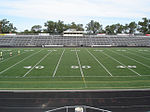Summit Avenue (St. Paul)

Summit Avenue is a street in St. Paul, Minnesota, United States, known for being the longest avenue of Victorian homes in the country, having a number of historic houses, churches, synagogues, and schools. The street starts just west of downtown St. Paul and continues four and a half miles west to the Mississippi River where Saint Paul meets Minneapolis. Other cities have similar streets, such as Prairie Avenue in Chicago, Euclid Avenue in Cleveland, and Fifth Avenue in New York City. Summit Avenue is notable for having preserved its historic character and mix of buildings, as compared to these other examples. Historian Ernest R. Sandeen described Summit Avenue as "the best preserved example of the Victorian monumental residential boulevard."Summit Avenue is part of two National Historic Districts and two City of Saint Paul Heritage Preservation Districts. The National Historic Districts are the Historic Hill District, an irregular area roughly bounded by Lexington Avenue, Portland Avenue, Dale Street North, Marshall Avenue, Pleasant Street, and Grand Avenue (exclusive of the area within the Woodland Park Historic District), and the West Summit Avenue Historic District, a narrow area running from Oxford Street South west to the Mississippi River along Summit Avenue. The city districts are Summit Hill, also known as Crocus Hill, a triangular region from Lexington Avenue on the west, Summit Avenue on the north, and the bluffs (just north of Interstate Highway 35E) on the south, and Ramsey Hill, the area bounded by Summit Avenue, Dale Street, Interstate Highway 94, and a line running north from the Cathedral of St. Paul. Most of the houses in this district are large, distinctive houses built between 1890 and 1920. Summit Avenue was named one of 10 "great streets" nationally by the American Planning Association in 2008.
Excerpt from the Wikipedia article Summit Avenue (St. Paul) (License: CC BY-SA 3.0, Authors, Images).Summit Avenue (St. Paul)
Summit Avenue, Saint Paul Summit - University
Geographical coordinates (GPS) Address Nearby Places Show on map
Geographical coordinates (GPS)
| Latitude | Longitude |
|---|---|
| N 44.941361111111 ° | E -93.146555555556 ° |
Address
St. Thomas More Catholic Church
Summit Avenue
55105 Saint Paul, Summit - University
Minnesota, United States
Open on Google Maps









